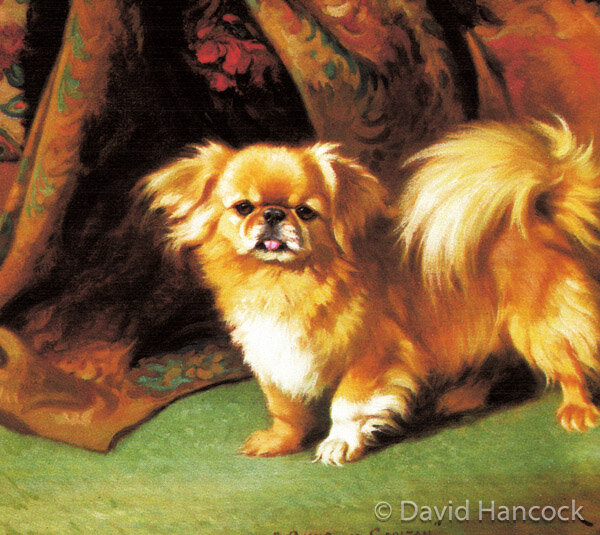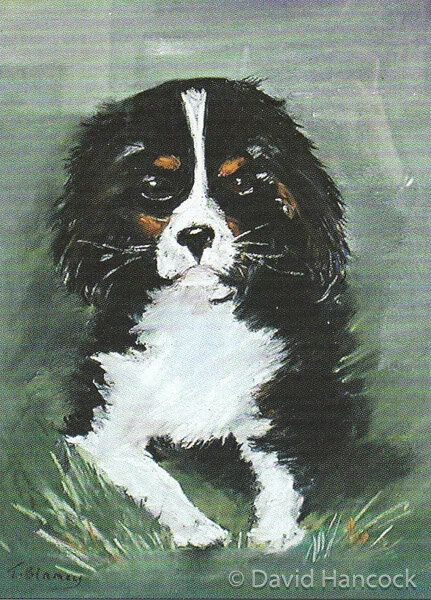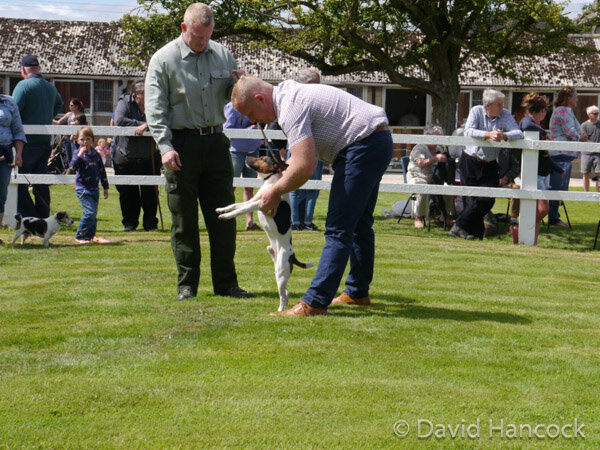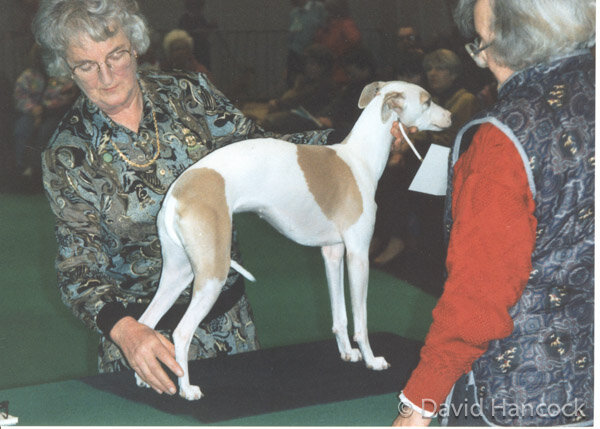1123
PUTTING DOG'S BEST FOOT FORWARD
By David Hancock
"No hoof, no horse" is a time-honoured saying in equestrian circles but I've never heard a cry of "No foot, no dog" in canine circles. And when I see judging at dog shows, I find it rare indeed to see a judge check a dog's feet. But which is more important, sound feet or set of tail? I suppose in an arena where dogs are valued solely for what they look like rather than what they can do, this is not surprising. Ignoring the soundness of your dogs' feet is however a recipe for disaster in breeding programmes. Unless sound feet are produced in every breed of dog from Toy breeds to giant ones, then the future of the domestic pedigree dog as an active animal is threatened. It is enlightening to look at the various Breed Standards and see what the different breeds are expected to walk on. Taking the smallest breeds, we come across some widely differing expectations, e.g.: the Australian Silky Terrier is required to have cat-like feet, as are the Griffon Bruxellois, the King Charles Spaniel, the Miniature Pinscher and the Pomeranian, but not the Chihuahua, the Pug or the Peke. The latter is expected to have large feet; the Pomeranian, the Lowchen (Little Lion Dog), Chihuahua, the Australian Silky and the Affenpinscher: small feet.
Does that mean small for the size of the dog or small when compared to a bigger breed? If judges look out, in these breeds, for feet smaller in proportion to the size of dog than is sensible, is that right or wrong according to the breed standard? It is surely essential for each breed of dog to have feet of a size appropriate to its weight. It is bad enough when a standard calls for unwise features such as: head - enormous, as in the Dogue de Bordeaux, or: head - massive, as in the Cane Corso. It is even more damaging if a dog's feet are bred to a harmful design. Being able to walk is fairly important to dogs! The Chinese Crested Dog is expected to have an extreme hare foot, narrow and very long, with unique elongation of the small bones between joints, especially in forefeet, which should almost appear to possess an extra joint. Sounds like the ingredients of deformity to me. Who approves such absurd requirements? The English Toy Terrier is required to have feet that are split up between toes, with the two middle toes of its front feet rather longer than the others. Tell me of a breed of dog that doesn't display these features - and I am aware of the Norwegian Lundehund with its extra toe.
The Japanese Chin has to be hare-footed, but the similarly constructed King Charles Spaniel must have a compact cat-shaped foot, although I suspect this means cat-like rather than shaped like a cat! The Papillon and the Tibetan Spaniel must have hare-like feet but the Pomeranian's and the Japanese Spitz's have to be cat-like. What is the thinking behind such differences? Similarly, why should the Miniature Pinscher need cat-like feet and the Italian Greyhound need hare-feet when even breed specialist judges never seem to check if they feature them? In the early years of dog-showing, breeds were judged to a scale of points. In the Yorkshire Terrier for example, the colour of hair on the body was assessed out of 20 points, whilst the legs and feet were only capable of scoring 5 points. Can this be the right priorities? Dogs walk on their feet, using their legs; isn't their locomotion of far greater importance than the colour of body hair? In the Maltese, the length and texture of the coat could attract 20 points, the legs and feet only a quarter of that. Is it surprising that some small dogs move badly? The Italian Greyhound's feet could total 8 points - the same as its tail. Who approves such misguided thinking?
Turning to the gundog group, a round compact foot is favoured. But the Brittany and the Irish Setter have to have small feet. The Irish Water and Clumber Spaniels are expected to have large feet, the Field Spaniel feet which are not too small. The Golden Retriever should have cat-like feet, the Chesapeake Bay Retriever hare-feet. The Italian Spinoni that I see have huge feet, against a breed standard that doesn't mention size of feet, but the Irish Water Spaniels seem to have feet in proportion to their body-size. The Spinone is supposed to have round front feet but 'slightly oval' hind feet. Does the size and shape of a gundog's foot matter?
In her informative book 'The Hungarian Vizsla' of 1985, Gay Gottlieb writes: "The difference between a cat foot and a hare foot is purely in the length of the third digital bone. In the hare foot the third digital bone is longer than the same bone in the cat foot. The hare foot allows increased leverage action and therefore speed, since the Vizsla does not need 'speed' (as does the greyhound), so much as endurance in the field, the cat foot is the most effective, the shorter more compact foot is less subject to injuries and its reduced leverage action lessens the strain on the ligaments." If Gay Gottlieb is correct, then why does the Chesapeake Bay Retriever need a hare foot? Does the breed have a need for speed ahead of the other retrievers? I think not. In her instructive book 'All about the Labrador", the late Mary Roslin-Williams makes an important observation on the breed's feet: "...if when judging you see thin hindlegs, especially thin thighs, and hindfeet definitely out of proportion with the forefeet, which appear normal with good leg-bone, then beware and watch the hip-movement very carefully." How many judges look at the relative size of fore and hind feet? This is an important feature of balance in a dog.
The great experts on feet are the Foxhound breeders. Whatever contemporary attitudes towards the sport of foxhunting, there is no doubt in my mind that the foxhound is the best bred dog in the country. In his book on the sport, the renowned Lake District hound expert Richard Clapham wrote: "No matter what other good qualities a hound may possess, if his feet cannot stand wear and tear...his usefulness in life is therefore at an end." He went on to praise the hare foot or to him natural foot, claiming that the cat-like or club-foot needs more attention in kennels. He describes the hare foot as a fairly long, closely knit, shallow-padded foot, similar to that of the wolf, coyote and fox. But the breed standard of hounds like the Rhodesian Ridgeback and the Otterhound calls for a round compact foot.
The Basset Hound is required to have massive feet but be capable of great endurance in the field. Huge feet mean greater and longer contact with the ground and therefore more strain. No working hound benefits from massive feet. The Afghan Hound has to have the hindfeet not quite as broad as the forefeet yet is expected to have a smooth gait. The Sloughi is expected to have thin feet! but not the Saluki, the Greyhound or the Whippet. The desert terrain that I have seen Salukis operating in would have destroyed thin feet very early in the day. In his book 'The Greyhound', H. Edwards Clarke writes: "Broken toes, dislocated, knocked-up toes, broken nails, split webs figure large in any greyhound trainer's chapter of accidents. It stands to reason therefore that the ideal foot is the foot that proves the toughest and strongest and most resistant to injury. The outward signs of strength in a foot are compactness, with the knuckles held close and well arched. A compact, tight foot, generally speaking, is a good one, just as a loose 'hare foot', with long spidery toes, is a weak one and therefore bad." I do not see why a tight hare foot cannot be sound however.
The sled dogs need sound feet if they are to function, with their breed standards varying too on this subject. The Alaskan Malamute has to have large feet, the Siberian Husky medium sized feet and the Eskimo Dog has to have 'rather large' feet. But whereas the Malamute and the Siberian Husky have to possess compact feet, the Samoyed should not have round cat feet. Most of the sled dog breeds that I see at shows have cat-like feet, very compact. Another northern spitz breed, the Finnish Lapphund has to display oval feet, the Finnish Spitz is preferred with round feet and the Elkhound comparatively small, slightly oval feet. But does any judge look at such fine detail? No working sheepdog would last a day without good feet. The Border Collie has to possess oval feet, as does the Bearded Collie, the Rough and Smooth Collies, the Shetland Sheepdog and the Polish Lowland Sheepdog. But the Old English Sheepdog is expected to have small round feet and the Belgian Shepherd Dog forefeet that are round and hindfeet slightly oval. The Australian Cattle Dog and the Australian Kelpie should have round feet but the Australian Shepherd is expected to have oval feet. Does it matter whether a herding dog's feet are round or oval?
If you study the judges' critiques from dog shows, it is quite clear that feet are rarely covered. Perhaps the limping Bullmastiff once awarded a third place at Crufts exemplifies the attitude towards feet at today's shows. One Deerhound critique indicated that the judge was concerned by the large percentage of incorrect feet, but didn't say why they were incorrect. Is that helpful? The critique from the Greyhound Club Championship Show of 1996 stated that: "The standard asks for 'well-knuckled toes', whilst there were hardly any that would be described as having poor feet, there were a substantial number of toes that could not be described as 'well-knuckled'." The inference here is that feet with toes that are not well-knuckled are still not bad feet. At Crufts in 1995 there were Rottweiler bitches there that had qualified despite having large ugly feet, according to the judge. The Breed Standard calls for hindfeet somewhat longer than the forefeet, but still demands round compact feet. Room for confusion here! But then why does a Basset Hound need unique feet for very common role?
The appearance of a dog's feet has more to do with exercise than Breed Standards. Dogs with soundly-constructed feet will still develop splay feet and slack pasterns if exercised on pastureland that is lush and soft. Road work is essential and is usually recommended to 'tighten up' the feet, but rough cinder tracks are probably best. Shape of foot can usually be linked to function. I see coursing Greyhounds with long hare feet and show Greyhounds with cat-like feet and toes compactly bunched. But both those descriptions are flawed. How many dog owners have seen the underside of a hare's foot? Cat-like originally meant like the round compact feet of the cat family, rather than like the ginger tom next door.
It is important to keep in mind too the origin of the breed when considering feet, i.e. what the breed was designed to do. Galloping breeds like the sighthounds have great freedom of the upper arm and elbows which are separated from the chest wall. The Greyhound's weight falls mainly on the toe-pads. The German Shepherd Dog's weight falls on to the heelpad of the forefoot. The Greyhound is therefore usually seen more 'up on the feet' comparatively in its stance. In her valuable book 'Foxhounds', Daphne Moore has written: "The foot of the foxhound is of the most vital importance. The terms 'cat-foot' and 'hare-foot' are frequently used, but the best type of forefoot is that which more resembles that of a wolf; a nice natural foot, on which the hound stands firmly, with the weight on all four toes and the heel." I would support that but I do see, especially in the smooth-haired breeds where it is more easily picked out, dogs in the ring with their heelpad not touching the ground, when standing. Feet therefore need to be judged from the side as well as being examined individually. An examination of the wear on the pads themselves will reveal a balanced or unbalanced stance or gait.
The soundness or otherwise of the foot can affect the balance of a dog. If the heelpad is not sharing the body weight of the dog with the toepads, then the latter are bearing extra weight and this will in time weaken the toes. The dog's knee will absorb what the toes haven't the strength to do. This is why at the turn of the century, when Foxhounds were favoured with massively timbered forelegs and a fleshy, contracted, bunched-up foot, so many stood over at the knee, to reduce the jarring. Such hounds had their weight all on the forehand, which in turn led to their shoulders becoming more upright. There is a danger in the pursuit of round, over-compact, knuckled-over, bunched-toed feet. If a judge has time to judge legs then he has time to examine feet! The bigger and heavier the breed, then the bigger will be its puppies' feet. The young entry need careful appraisal - it's the future of the breed. Earlier I wrote that the English Toy Terrier is required to have feet that are split up between toes, with the two middle toes of its front feet rather longer than the others. I have never seen even a specialist judge in this breed check on that feature.
From time to time, a committee of the Kennel Club looks at the wording of Breed Standards, in an attempt to avoid harmful end-effects on dogs from unwise written anatomical designs. The words on feet should receive their urgent attention. I am against a dog's feet being described in its breed blueprint as large, small, a different size fore and aft (as in a number of terrier standards) or being unhelpfully worded, as in the Irish Terrier's, whose feet have to be 'tolerably round' and 'moderately small'. At least the breed standard of the West Highland White Terrier asks for feet that are proportionate in size; so should every Breed Standard. Feet are a vital part of the dog's anatomy, more important than 'bite', colour of coat, length of coat, set of tail, length and carriage of ears and pigmentation. Dog show judges should murmur to themselves "No foot, no dog" before they begin their duties, advancing 'feet first' in every ring. Before writing 'movement disappointing' in the critique, a judge should ask 'did I examine the feet'? The feet may not exactly be the mirror of the soul but the soles of the feet can so often reveal the quality of the dog. For me the quality of judges starts at the feet of the exhibits. At least the dogs judged by them can actually walk off with a prize!





















